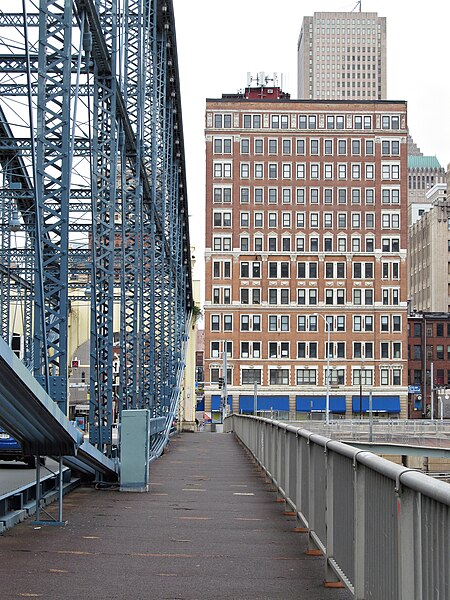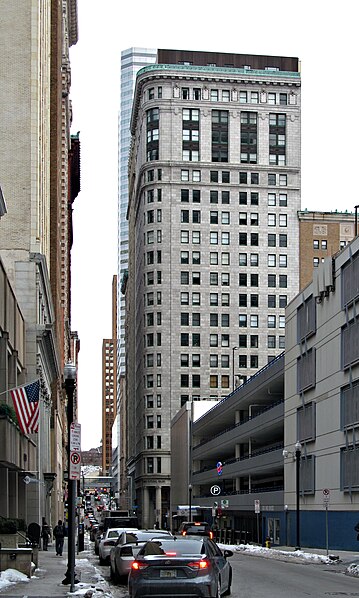
The House Building (1902, architect James T. Steen) looms before us as we cross the Smithfield Street Bridge.


The Burke Building was built in 1836, and rather surprisingly (considering that Pittsburgh was founded in 1758) it’s the oldest building downtown outside Fort Pitt. The Great Fire of 1845 just missed it. The architect was John Chislett, Pittsburgh’s first resident architect, who also designed the Butler Street gatehouse for the Allegheny Cemetery.

The Clark Building was built in 1928 at the same time as the Stanley Theater (now the Benedum Center) around the corner, and designed by the same architects—the Hoffman-Henon Company, which specialized in theaters but could also turn out a pretty good skyscraper in a sort of modernized Beaux-Arts classical style. The upper floors are apartments, but the lower floors are still, as they have been for many years, the center of the jewelry district downtown.

Colonial Place, off Ellsworth Avenue, is one of those little one-street enclaves in Shadyside that shut out the world as much as they can to create a tiny insular community. The architect here was George S. Orth, who also designed a couple of prominent millionaires’ mansions in Allegheny West. The landscape design by E. H. Bachman was just as important, and the sycamore trees he specified have matured into elegant sculptures as attractive when the leaves are off as they are in full leaf.



Now converted to luxury apartments as “The Carlyle,” this classical Fourth Avenue bank tower was designed by the firm of MacClure and Spahr. Benno Janssen, who was working at the firm, is said to have had a large part in the design. It opened in 1906. Curiously, the building behind it, the Commonwealth Bank Building, was built at the same time and reached exactly the same height, 300 feet.

A firehouse that looks like the Platonic ideal of a firehouse. The tower commands a view that must extend for miles: not only is the tower itself tall, but the station is built at the crest of a hill.


Addendum: The architects were Thomas W. Boyd & Co. This is a near-duplicate of the firehouse by the same firm at 3000 Chartiers Avenue, Sharaden, even though that one is dated 1928, eighteen years later

The Mellon Institute, designed by the prolific Benno Janssen, claims the largest monolithic columns in the world. Columns like these are usually made as a series of joined cylinders, but each column here is a single piece of stone. When the client wants to send the message “I spent money on this,” nothing is more effective than giving him the world’s largest something-or-other.
Note how, unlike most other monumental buildings in Oakland, the Mellon Institute has retained the sooty evidence of decades of heavy industry.

Addendum: Note the comment below with the rival claim of the South Carolina State House, whose monolithic columns claim to be taller by a foot. As in all such questions, of course, we can make pedantic distinctions one way or another: it depends on how we define “large.” Columns of the Corinthian order are more slender in proportion to their height; we have to say what we mean by “largest” before we can settle the question. The only thing that matters, though, is that the columns in Columbia are beautiful in themselves and add considerably to the beauty of one of our distinguished Greek Revival buildings. It is not necessary to take down one of the South Carolinian columns and weigh it to say that they are magnificent achievements.